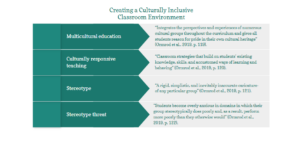
Vocabulary
There are many factors that go into developing a classroom with a culturally inclusive atmosphere and ensuring that both teachers and students are aware and responsive to the difference in thoughts and actions of diverse cultural and ethnic groups of people. Educational Psychology: Developing Learners provides several suggestions on how to create a culturally inclusive classroom environment, however, it is not limited to the suggestions made. Educators are encouraged to come to grips with their own cultural lens and biases, “be sensitive to the culture shock that recent immigrants may be experiencing, incorporate the perspectives and traditions of many cultures into the curriculum, build on students’ strengths, and adapt instructional methods to their preferred ways of learning and behaving, work hard to break down students’ stereotypes of particular ethnic groups, bring cultural diversity to culturally homogeneous classrooms, and foster democratic ideals and empower students to bring about meaningful change” (Omrod et al., 2019, pp. 117-123). Some terms that are critical towards making these happen are multicultural education, culturally responsive teaching, stereotypes, and stereotype threats. Another issue that should be addressed in classrooms is students’ stereotypes and prejudices. In order to have a classroom environment that is comfortable for students, it takes the efforts of not only the teacher, but also the students to recognize, understand, and respect cultural and ethnic differences that exist in this world.
Multicultural education “isn’t limited to cooking ethnic foods, celebrating Cinco de Mayo, or studying famous African Americans during Black History Month” (Omrod et al., 2019, pp. 119). Many teachers should avoid merely focusing on the basic aspects of a culture. Yes celebrations, food, and nature are valuable, but students need to learn beyond that and explore the history and the people of a culture as well. It’s also important to note that teachers don’t necessarily have to agree with or approve of the values or practices of a different culture in order to learn about it and its perspectives. Educators should also aim to “Use curriculum materials that represent all cultures and ethnic groups as competent, legitimate participants in mainstream society, rather than as exotic curiosities who live in a separate world” (Omrod et al., 2019, pp. 123).

From the Experiencing Firsthand activity in Educational Psychology: Developing Learners
(Omrod et al., 2019, pp. 121)
It is significant for educators to be mindful, patient, and understanding of various cultural and ethnic groups and their practices and values. This is a process that is not necessarily comfortable or pleasant for many, however, it allows educators to put themselves into a position of understanding and open mindedness rather than one of assumptions. Educators must continually make an effort to learn about and interact with various cultures. They can attend cultural events, read books or other works that are written for or by BIPOC creators, interact with students and their families. This produces benefits for both students and teachers, as more meaningful connections are made. “When teachers lose sight of the strong influence of culture on students, they often underestimate students’ intellectual potential, academic achievement, and language abilities” (Omrod et al., 2019, pp. 120). With this, teachers should hold high expectations for all students, but also be considerate of why some students might not meet these standards. Sometimes immigrant students may need more help with academic skills and knowledge, in comparison to non-immigrant students. They may also face other challenges such as getting teased or excluded by other students.